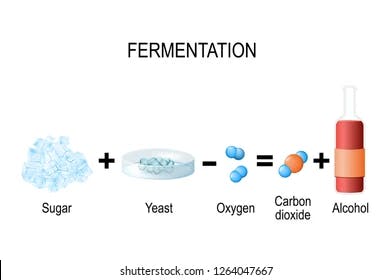TL;DR Science: Yeast & Fermentation
By Angelo Chen
August 04, 2021 · 3 minute read
What is Yeast?
Yeasts are a class of living, single-celled fungi that includes over 1,500 different species. Despite this, the term yeast has become synonymous with the one species Saccharomyces cerevisiae, also known as baker’s yeast, which is used in (surprise!) baking and in fermenting alcoholic drinks. Although there are a wide variety of other yeast species, this is by far the most common, and for good reason.
S. cerevisiae is used worldwide for its versatility in bread-making, the brewing of alcoholic beverages, and in the fermentation of various nonalcoholic drinks, like kombucha. This is because S. cerevisiae can withstand many environments, including those of high alcohol content as well as high and low temperatures. But before we can explore these purposes individually, you first have to understand what fermentation is.

What is Fermentation?
Fermentation is a process that converts carbohydrates (sugars, like glucose, and starches) into energy for a microorganism to survive, and (more importantly) also produces byproducts such as carbon dioxide, lactic acid, and alcohols. These byproducts are what result in the rising of bread, the tang of kombucha, and the alcohol in beer. However, because of this alcohol content, many yeasts actually die in the process of fermentation, which is why the family Saccharomyces, including S. cerevisiae, are most commonly used for all purposes.
Fermentation is a primarily anaerobic process or one that occurs in the absence of oxygen. For this reason, the containers used in fermentation are often airtight, to promote fermentation (e.g. barrels, and mason jars). However, with enough sugar or starch, the yeast S. cerevisiae can perform fermentation even in environments with oxygen, which is why bread dough doesn’t have to be kept airtight when baking.
Yeast in Baking
Perhaps the most famous purpose for yeast, bread. The yeast S. cerevisiae, aka baker’s yeast, has become a staple ingredient in households across the globe, solely for its importance in baking. Being able to convert sugar into carbon dioxide, yeast is a key leavener in baking, allowing for soft, delicious bread, as well as other baked goods, like pastries.
Check out this video from professional chef J. Kenji López-Alt on (the science behind) baking bread!
Yeast in Brewing
Nearly every alcoholic beverage in existence is produced by fermentation. The alcohol in these drinks, also known as ethyl alcohol, or ethanol for short, is created in the same fermenting process that makes bread rise, but without the heat of an oven, it doesn’t evaporate, as it does in bread.
The primary yeasts used in brewing beer are S. cerevisiae, known as ale yeast, and Saccharomyces pastorianus, known as lager yeast, used to make ales and lagers (you can take a guess at which makes which). After starches have been steeped in water to extract their sugars, these yeasts can react with those carbohydrates to produce the alcohol in beer, as well carbon dioxide, which contributes to the fizziness of beer.
Other Uses of Yeast
S. cerevisiae is also used in the fermentation of various other beverages, such as root beer, kvass, kombucha, kefir, kumis, and mauby. Although these are fermented drinks, many consider them nonalcoholic because the fermentation process is halted very early on, resulting in very low alcohol content.
Yeast can also be used as a nutritional supplement, but these yeasts are deactivated, and can no longer be used for fermentation. In fact, much of the yeasts used to make nutritional yeast are actually those that have been deactivated after decades of fermentation in breweries. Because the flavor is described as nutty or cheesy, it is popular with vegetarians and vegans as a condiment or a substitute for cheese.
TL;DR:
There are many different types of yeast, but the yeast used in virtually everything is the species Saccharomyces cerevisiae. Yeasts convert carbohydrates into carbon dioxide and alcohol in a process known as alcoholic fermentation. This is what gives bread its rise, alcoholic drinks their fizziness, and drinks like Kefir, their sour ‘tang’.
Sources:
https://mb-labs.com/testlibrary/osmophilic-yeast-mold-2/
https://www.ncbi.nlm.nih.gov/pmc/articles/PMC6730531/
https://www.ncbi.nlm.nih.gov/pmc/articles/PMC7466055/
https://sciencing.com/alcoholic-lactic-acid-fermentation-5635612.html
https://www.britannica.com/science/fermentation
https://en.wikipedia.org/wiki/Yeast
https://redstaryeast.com/science-yeast/types-of-yeast/
https://pubs.acs.org/doi/10.1021/jp7111395
https://www.delish.com/cooking/recipe-ideas/a25810151/how-to-make-sourdough-bread-recipe/
https://en.wikipedia.org/wiki/Brewing
https://en.wikipedia.org/wiki/Yeast_in_winemaking
https://en.wikipedia.org/wiki/Wheat_beer#Weissbier
https://en.wikipedia.org/wiki/Brettanomyces
https://en.wikipedia.org/wiki/Torulaspora_delbrueckii
https://en.wikipedia.org/wiki/Lambic
https://www.publicdomainpictures.net/en/view-image.php?image=148933&picture=beer-fermentation
Did you enjoy this article?
About The Author
Angelo is currently a junior at Suncoast Community High School. He enjoys spending time with his dog, and playing volleyball and violin as hobbies. He also enjoys doing math, in and out of school. If you have any questions about this article, feel free to contact him at angelo@sciteens.org.